Sciatica and lower leg pain is a common condition that causes pain, tingling, or numbness radiates from your lower back down one leg. This happens when the sciatic nerve, the longest and thickest nerve in your body, gets irritated or compressed. To understand why this pain travels, it helps to know a little about this important nerve.
The sciatic nerve runs from the lower back through the buttocks to the legs and feet. Because this nerve has such a long path, when it’s irritated or compressed at its root in the lower spine, it can cause symptoms that travel along its entire length. This is why you might feel sensations not just in your back, but all the way down to your legs and feet.
Sciatica pain often radiates from the lower back to the leg and can feel sharp, burning, or like “pins and needles.” It may also cause muscle weakness in severe cases.
These sensations are caused by a few things. Sciatica can result from inflammation, a herniated disc, or spinal stenosis, all of which irritate or compress the nerve. In some cases, the pain you feel in your leg might actually be coming from your lower back, a phenomenon called referred pain.
Consult a doctor or physical therapist for diagnosis and treatment, such as stretches, medication, or surgery. The good news is that sciatica is usually treatable, and most people recover with time and proper care.
Sciatica pain can feel sharp, burning, or like “pins and needles,” often radiating from the lower back to the leg. This happens because of the intricate workings of our nervous system, specifically when nerves are irritated or compressed. Irritated nerves send pain signals along their length.
Causes and Contributing Factors of Sciatica and Lower Leg Pain
Irritation and compression are key culprits of sciatica and lower leg pain, causing various complications:
- Ischemia: Nerve compression reduces blood supply, causing pain and dysfunction.
- Demyelination: Nerves have a protective coating called myelin, which helps them conduct signals efficiently. Prolonged compression can damage this coating, leading to abnormal nerve conduction, resulting in radiating pain and other neurological symptoms.
- Axonal Damage: In severe cases, compression can actually damage the nerve fibers themselves, called axons. This can lead to more pronounced and potentially long-lasting symptoms.
- Neurogenic Inflammation: Compressed nerves release inflammatory substances, heightening pain sensitivity in surrounding tissues.
Referred pain in sciatica occurs when nerve signals from the lower back cause shooting pain in the leg. Understanding these mechanisms helps diagnose sciatica by identifying how nerve irritation, compression, and referred pain contribute to symptoms.
Sciatica can be puzzling, often caused by lower back issues like herniated discs or spinal stenosis, which compress nerve roots and trigger radiating pain. This happens because of the intricate network of nerves, muscles, and other structures that connect your lower back to your lower legs.
First and foremost, your nerves are messengers of pain. The sciatic nerve, the body’s largest, runs from the lower back through the legs; when compressed or irritated, it causes radiating pain and numbness, a hallmark of sciatica.
Narrowed foramina, caused by conditions like spinal stenosis or herniated discs, can compress nerves, leading to pain signals radiating down the leg. Referred pain occurs when your brain misinterprets signals, causing leg pain that actually originates in the lower back.
Sensory nerves sharing spinal pathways can cause lower back pain to be felt in the leg, as seen in disc degeneration. Other contributing factors, like reduced blood flow from conditions such as diabetes and muscle compression, worsen nerve issues, causing pain and discomfort.
Impact of Blood Flow on the Sciatic Nerve
Sciatica and lower leg pain are often influenced by the health of the sciatic nerve’s blood supply. Blood vessels deliver nutrients and oxygen to the nerve, and disruptions can cause problems.
The sciatic nerve has a complex network of blood vessels that nourish it. These vessels come from nearby arteries, veins, and vessels along the nerve itself. These two systems are interconnected, ensuring that the nerve receives a steady supply of blood.
However, this blood flow can be affected by certain conditions, like diabetes. In diabetic neuropathy, high blood sugar damages small blood vessels, reducing nerve blood flow and causing pain, numbness, and tingling.
It’s also worth noting that the sciatic nerve can have some anatomical variations. For example, the nerve may split and rejoin before continuing down the leg, or it may take a slightly different path through the muscles in the buttocks. These variations are usually normal but can aid diagnosis and treatment of sciatica.
In short, a healthy blood supply is essential for the sciatic nerve to function correctly. When this blood flow is compromised, it can contribute to pain and other symptoms.
“It is estimated that around 16% of the population may have variations in the anatomical structure of the sciatic nerve,” according to Spine Health. “While the variants are considered normal, they may increase the risk of developing sciatica pain due to impingement, entrapment, or irritation of the nerve root. In around 10% of the population, the nerve may divide at a level above the popliteal fossa but then does not merge and courses down in two separate branches (some researchers may not consider this possibility as a variant).”
Practical Tips for Managing Sciatica and Lower Leg Pain
Sciatica and lower leg pain can make travel uncomfortable, but with planning, you can manage pain and enjoy your trip. Movement and support options include:
- Stretching: Gentle stretches can work wonders for sciatica pain. Pack a stretching strap or travel yoga mat for simple stretches in your hotel or during your flight. Stretching can help loosen tight muscles and reduce pressure on the sciatic nerve.
- Foot Hammock: On long flights, elevating your legs can make a big difference. A foot hammock that attaches to the tray table can help you keep your legs extended and improve irculation, even in cramped spaces.
- Hip Brace: A supportive hip brace can provide stability and pain relief, whether you’re working out on the go or simply sitting for long periods.
- Lumbar Support: Airplane seats often lack proper lumbar support, which can worsen sciatica pain. A lumbar support pillow can help maintain the natural curve of your spine and reduce pressure on your lower back.
- Seat Cushion: A good seat cushion can distribute your weight more evenly and reduce pressure points, making sitting more comfortable.
Take note of targeted relief tools as well:
- Massage Ball: Use a massage ball to roll out tight muscles in your glutes and back. This can improve blood flow and release tension, reducing pressure on the sciatic nerve.
- Heating Pad: A portable heating pad can provide soothing warmth and relieve muscle tightness.
- Topical Treatments: Consider packing a topical treatment containing anti-inflammatory ingredients like turmeric or essential oils to help reduce pain and inflammation.
Medication and supplements are integral for some patients depending on their circumstances:
- Prescription Medication: If you have prescription medication for sciatica pain, be sure to pack it in your carry-on bag.
- Over-the-Counter Options: Anti-inflammatory medications and supplements can also be helpful for managing pain and inflammation.
Pain Relief and Planning On-the-Go
Dealing with sciatica and lower leg pain can make travel difficult, but planning can help you stay comfortable on the go. Many people discover that certain products can make a big difference in managing their pain and making their journeys more enjoyable.
“I eventually found the right combination of therapy and medication to get most of my pain under control for day-to-day activities, but my sciatic nerve pain will still flare up when I sit for too long,” a contributor and patient states in Conde Nast Traveler. This isn’t usually an issue at home, when I can stand and stretch my legs or go for a walk whenever I need to (or work from my couch with my legs completely outstretched)—but on long-haul flights in a window seat? That’s a whole different story.”
Whether you’re taking a long car ride or flying across the country, consider packing items that provide support and reduce pressure on your sciatic nerve. A lumbar support pillow helps maintain posture and reduce lower back strain. A comfortable seat cushion can also help distribute your weight more evenly and minimize pressure points. And don’t forget a good travel pillow to support your neck and prevent your head from falling forward, which can worsen sciatica pain.
You can personalize your treatment by exploring sciatica treatment options at Wellness and Pain. We offer conservative treatments, routine visits, and minimally invasive quick-recovery procedures. We can keep you free of problems by providing lifestyle education and home care advice.
This enables you to avoid and manage issues, quickly relieving your inhibiting lifestyle conditions when complications arise. We personalize patient care plans based on each patient’s condition and unique circumstances. Wellness and Pain can help improve wellness, increase mobility, relieve pain, and enhance your mental space and overall health.
Wellness and Pain
You can personalize your treatment by exploring sciatica and lower leg pain options at Wellness and Pain. We offer conservative treatments, routine visits, and minimally invasive quick-recovery procedures. We can keep you free of problems by providing lifestyle education and home care advice.
This enables you to avoid and manage issues, quickly relieving your inhibiting lifestyle conditions when complications arise. We personalize patient care plans based on each patient’s condition and unique circumstances. Wellness and Pain can help improve wellness, increase mobility, relieve pain, and enhance your mental space and overall health.











